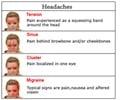- Botulinum toxin - (https://www.migrainetrust.org/living-with-migraine/treatments/botox/)
- What is migraine? - (https://www.migrainetrust.org/about-migraine/migraine-what-is-it/more-than-just-a-headache/)
- Migraine - A-Z Health Topics - (https://www.womenshealth.gov/a-z-topics/migraine)
- Migraine - Migraine Research Foundation - (https://migraineresearchfoundation.org/about-migraine/what-is-migraine/)
- Treatment of Acute Migraine Headache - (https://www.aafp.org/afp/2011/0201/p271.html)
- Migraine - (https://medlineplus.gov/ency/article/000709.htm)
- The diagnosis and treatment of chronic migraine - (https://www.ncbi.nlm.nih.gov/pmc/articles/pmc4416971/)
- What is a migraine headache? - (https://familydoctor.org/condition/migraines/)
What is Migraine
Migraine is a chronic disorder characterized by headache; and nausea, vomiting or sensitivity to light and sound.
Many are unable to differentiate migraine from other headaches. A typical migraine headache is usually felt on one side of the head and patients describe it as throbbing or pulsating kind of pain. These headaches are ‘episodic headaches’ means they can occur anywhere from once or twice a year to 1-4 times a month but in between, there are prolonged pain free intervals.(1✔ ✔Trusted Source
What is migraine?
Go to source)
Migraine is three times more common in women than men. It generally appears for the first time between 10-45 years of age.
Previously the doctors linked migraines with the opening and narrowing of blood vessels in the head. However, now they believe that it is related to genes that control the activity of some brain cells. The exact chain of events still remains unclear. Migraine attacks are believed to begin in the brain, and involve nerve pathways and chemicals. This abnormal brain activity triggers a migraine.
Avoiding the triggering factors and using preventive migraine drugs can help reduce the frequency of attacks. Treatment with analgesics (to relieve the pain) and anti-emetics (to relieve the nausea or vomiting) can help relieve symptoms during a migraine attack. Treatments to relieve stress can also be helpful to prevent migraine.
Botox, is another method of treatment that inhibits pain in chronic migraine by suppressing the nerve cells in the trigeminovascular system, which plays a key role in the headache phase of a migraine attack.(2✔ ✔Trusted Source
Botulinum toxin
Go to source)
















